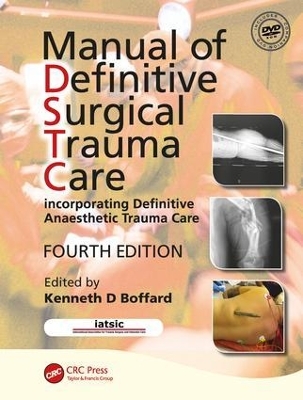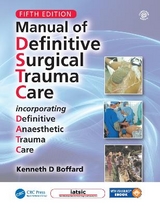
Manual of Definitive Surgical Trauma Care, Fourth Edition
Productivity Press
978-1-4987-1487-7 (ISBN)
- Titel erscheint in neuer Auflage
- Artikel merken
Developed for the International Association for Trauma Surgery and Intensive Care (IATSIC), the Manual of Definitive Surgical Trauma Care is ideal for training all surgeons who encounter major surgical trauma on an infrequent basis. It is designed to support general surgeons who, whether by choice or necessity, are confronted with major surgical injury but may not necessarily have the experience or expertise required.
This edition is updated to incorporate recent developments and covers every aspect of surgical trauma care covered by the Definitive Surgical Trauma Care (DSTC) course. It provides additional emphasis on anaesthesia and military components, reflecting changes in worldwide surgical trauma experience.
Written by faculty who teach the DSTC Course, this book will give you the confidence to focus on life-saving surgical techniques when faced with challenging and unfamiliar incidents of trauma.
Edited by Kenneth D. Boffard, BSc(Hons), FRCS, FRCPS, FCS(SA), Emeritus Professor, Department of Surgery, Milpark Hospital and University of the Witwatersrand, South Africa
TRAUMA SYSTEM AND COMMUNICATION PRINCIPLES
Overview
Resuscitation in the Emergency Department
Management of Major Trauma
Emergency Department Surgery
Communication and Non-Technical Skills in Major Trauma
Overview
Communication in the Trauma Setting
Leadership in Trauma Care
Communication in Damage Control
PHYSIOLOGY AND THE BODY’S RESPONSE TO TRAUMA
Resuscitation Physiology
Metabolic Response to Trauma
Shock
Transfusion in Trauma
Indications for Transfusion
Transfusion Fluids
Effects of Transfusing Blood and Blood Products
Autotransfusion
Red Blood Cell Substitutes
Massive Haemorrhage/Massive Transfusion
Damage Control Surgery
Introduction
Damage Control Resuscitation (DCR)
Damage Control Surgery (DCS)
The Neck
Overview
Management Principles
Treatment
Access to the Neck
PHYSIOLOGY AND THE BODY’S RESPONSE TO TRAUMA
The Chest
Overview
Emergency Department Thoracotomy
Surgical Approaches to the Thorax
Emergency Department Thoracotomy Technique
Definitive Procedures
The Abdomen
Trauma Laparotomy
Bowel and Diaphragm
The Liver and Biliary System
Spleen
Pancreas
The Duodenum
Abdominal Vascular Injury
The Urogenital System
The Pelvis
Introduction
Anatomy
Classification
Clinical Examination and Diagnosis
Resuscitation
Pelvic Packing
Associated Injuries
Compound Pelvic Injuries
Extremity Trauma
Overview
Management of Severe Injury to the Extremity
Management of Vascular Injury of the Extremity
Crush Syndrome
Management of Open Fractures
Massive Limb Trauma: Life versus Limb
Compartment Syndrome
Fasciotomy
Complications of Major Limb Injury
Head Trauma
Introduction
Injury Patterns and Classification
Measurable Physiological Parameters of Brain Function
Pathophysiology of Traumatic Brain Injury (TBI)
Initial Management of TBI
Cerebral Perfusion Threshold
Intracranial Pressure (ICP) Threshold and Indications for Monitoring
Imaging
Indications for Surgery
Adjuncts to Care
Paediatric Considerations
Pearls and Pitfalls
Burns
Overview
Anatomy
Depth of the Burn
Total Body Surface Area (TBSA) Burned
Management
Special Areas
Adjuncts in Burn Care
Criteria for Transfer
Special Patient Situations
Paediatrics
The Elderly
Futile Care
Critical Care of the Trauma Patient
Introduction
Goals of Trauma Intensive Care Unit (ICU) Care
Phases of ICU Care
Hypothermia
Systemic Inflammatory Response Syndrome
Multisystem Organ Dysfunction Syndrome (MODS) or Multiple Organ Failure (MOF)
Coagulopathy of Major Trauma
Recognition and Treatment of Raised Intracranial Pressure
Recognition of Acute Renal Failure (ARF) and Acute Kidney Injury (AKI)
Evaluation of Metabolic Disturbances
Pain Control/Sedation/Delirium
Family Contact and Support
ICU Tertiary Survey
Nutritional Support
Preventive Measures in the ICU
Antibiotics
Respiratory Support
Surviving Sepsis Guidelines
Abdominal Compartment Syndrome (ACS)
Organ Donation
DIAGNOSTIC AND THERAPEUTIC TECHNOLOGY
Minimally Invasive Surgery in Trauma
Technique
Thoracic Injury
Diaphragmatic Injury
Abdominal Injury
After Non-Operative Management
Risks of Laparoscopy in Trauma
Radiology in Trauma
Introduction
Radiation Doses and Protection from Radiation
Pelvic Fractures
Blunt Splenic Injuries
Liver Injuries
Aortic Rupture and Injury to Middle-Sized Arteries
Ultrasound in Trauma
Applications of Ultrasound in Trauma – Introduction
Extended Focussed Assessment by Sonography for Trauma (E-FAST)
Other Applications of Ultrasound in Trauma
Training and Pitfalls
ASPECTS OF SPECIALIZED CARE
Austere or Military Environments
Introduction
Injury Patterns
Emergency Medical Services Systems
Triage
Mass Casualties
Evacuation
Resuscitation
Blast Injury
Battlefield Analgesia
Battlefield Anaesthesia
Critical Care
Translating Military Experience to Civilian Trauma Care
Trauma Anaesthesia
Introduction
Preparation for Damage Control
Damage Control Resuscitation (DCR)
Damage Control Surgery
Anaesthesia Induction in Hypovolaemic Shock
Battlefield Anaesthesia
APPENDICES
Appendix A Trauma Systems
Introduction
Inclusive Trauma System
Components of an Inclusive Trauma System
Management of the Injured Patient within a System
Steps in Organizing a System
Results and Studies
Appendix B Trauma Scores and Scoring Systems
Introduction
Physiological Scoring Systems
Anatomical Scoring Systems
Co-morbidity Scoring Systems
Outcome Analysis
Trauma Scoring Systems
Appendix C The Definitive Surgical Trauma Care Course: Course Requirements and Syllabus
Background
Course Development and Testing
Course Details
IATSIC Recognition
Course Information
Appendix D Definitive Surgical Trauma Care Course – Core Surgical Skills
The Neck
The Chest
The Abdominal Cavity
The Liver
The Spleen
The Pancreas
The Duodenum
The Genitourinary System
Abdominal Vascular Injuries
Peripheral Vascular Injuries
Appendix E Briefing for Operating Room Scrub Nurses
Introduction
Preparing the Operating Room
Surgical Procedure
Abdominal Closure
Instrument and Swab Count
Medicolegal Aspects and Communication Skills
Critical Incident Stress Issues
Conclusion
| Erscheint lt. Verlag | 16.9.2015 |
|---|---|
| Zusatzinfo | No Color; 47 Line drawings, black and white; 122 Illustrations, black and white |
| Verlagsort | Portland |
| Sprache | englisch |
| Maße | 189 x 246 mm |
| Gewicht | 839 g |
| Themenwelt | Medizinische Fachgebiete ► Chirurgie ► Unfallchirurgie / Orthopädie |
| Medizin / Pharmazie ► Medizinische Fachgebiete ► Notfallmedizin | |
| ISBN-10 | 1-4987-1487-0 / 1498714870 |
| ISBN-13 | 978-1-4987-1487-7 / 9781498714877 |
| Zustand | Neuware |
| Haben Sie eine Frage zum Produkt? |
aus dem Bereich


